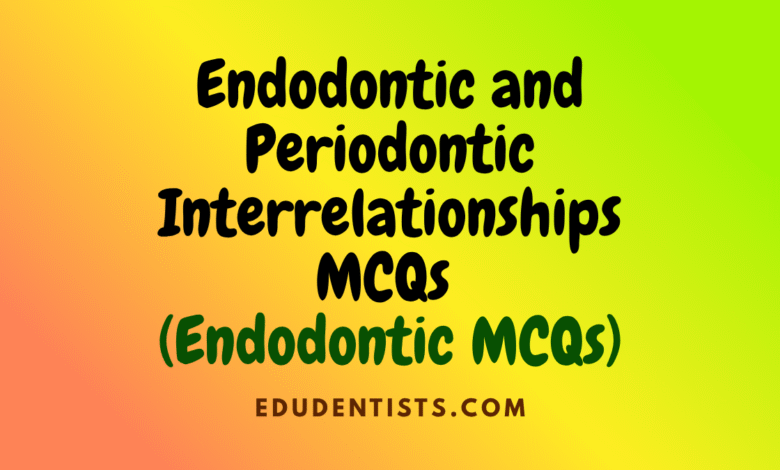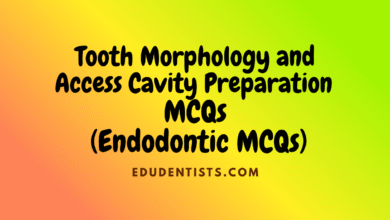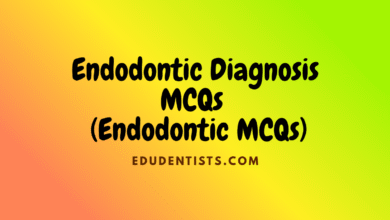Endodontic and Periodontic Interrelationships MCQs
Endodontic and Periodontic Interrelationships MCQs

Endodontic and Periodontic Interrelationships MCQs
Endodontic and Periodontic Interrelationships MCQs
1. Which of the following statements about the palatogingival groove is correct:
A) The incidence of occurrence is highest for the maxillary central incisor.
B) Palatogingival grooves, when they occur, extend from the cingulum to the root apex.
C) Developmental radicular grooves are found only on the lingual surface.
D) The palatogingival groove is an etiology for periodontal probing defects but does not contribute to endodontic pathosis.
E) The incidence ranges from 2 to 9, and the maxillary lateral incisor is the tooth most often involved.
2. The concomitant pulpal and periodontal lesion:
A) Consists of two distinct disease processes involving the same tooth
B) Is characterized by pulpal necrosis and the formation of a draining sinus tract through the attachment apparatus
C) Is best described as a periodontal lesion that exposes lateral or accessory canals, resulting in pulpal inflammation or necrosis
D) Is the result of endodontic and periodontal lesions that have coalesced
3. Which of the following statements about cervical projections is correct:
A) The prevalence ranges from 18 to 45.
B) They result from failure of the enamel and cementum to meet at the cementoenamel junction.
C) They are present in teeth that have a palatogingival groove and prevent tissue attachment to the root.
D) They are initial calcifications in the pulp and are a direct result of periodontal pathosis.
4. Which of the following statements about lateral periodontal cysts is correct:
A) The lesions occur most often in women in the third and fourth decades of life.
B) They are radiolucent areas located primarily in the maxillary premolar and canine regions.
C) Radiographically they are less than 1 cm in diameter and have a diffuse peripheral border.
D) Histologically the epithelium is keratinized.
E) The reduced enamel epithelium is the most likely origin of the epithelium.
5. All of the following are indications for root resection except one. Which is the exception:
A) Vertical root fracture involving the mesial root of a mandibular first molar.
B) Internal root resorption perforating the mesial root of a mandibular first molar in the cervical area.
C) Lateral perforation of the distal canal in a mandibular second molar with a C-shaped configuration.
D) Isolated bone loss around the distobuccal root of a maxillary first molar.
E) Furcal perforation in a mandibular molar.
6. Which of the following statements is correct with regard to the treatment of a vital maxillary first molar with isolated vertical bone loss and a 9mm probing depth associated with the distobuccal root:
A) The distobuccal root should be resected, and the pulp stump can be capped with a calcium hydroxide base and amalgam.
B) The distobuccal root can be removed before endodontic treatment; however, root canal treatment should be completed as soon as possible.
C) Ideally, the root is resected before root canal treatment is performed.
D) Root canal treatment should be completed before resection of the root.
7. Which of the following statements about guided tissue regeneration (GTR) is correct:
A) The GTR barrier prevents contact of the connective tissue and the osseous walls protecting the clot.
B) The combined endodontic-periodontic lesion has the most favorable prognosis when a membrane is used.
C) The standard of care dictates osseous grafting and membrane placement for osseous defects in cases involving root-end surgery.
D) Bioresorbable membranes eliminate the need for a second surgery for membrane removal but have lower success rates.
8. All of the following statements about forced eruption are correct except one. Which is the exception:
A) Forced eruption in the presence of inflammation may cause osseous defects to become deeper.
B) Esthetics may be compromised by the presence of an immature-appearing tissue after the procedure.
C) Extrusions of less than 4mm are most successful.
D) It is an alternative to surgical crown lengthening.
E) Prognostic studies indicate that forced eruption is not a predictable treatment technique.
9. Which of the following statements best describes retrograde periodontitis:
A) Inflammation from the periodontal sulcus migrates apically, causing pulpal inflammation and eventually necrosis.
B) Pulp necrosis occurs, and the toxic irritants cause inflammation that migrates to the gingival margin, creating a periodontal pocket.
C) Irritants gain access to the periodontal tissues at the site of a vertical root fracture, producing tissue destruction that mimics periodontitis.
D) Pulp necrosis results in the formation of an apical radiolucent lesion characterized by loss of the lamina dura.
10. Which of the following statements is correct with regard to a primary endodontic lesion with secondary periodontic involvement:
A) Pulp necrosis occurs initially, and an apical lesion forms. Apical migration of periodontal disease results in communication between the two lesions.
B) Treatment consists of performing endodontic treatment, which is followed by a 6- month recall examination. If the periodontal component is still present, periodontal treatment is initiated.
C) A primary endodontic lesion with secondary periodontic involvement has a poorer prognosis than a primary periodontal lesion with secondary endodontic involvement.
D) Pulp necrosis occurs, forming a sinus tract through the periodontal ligament; over time, this tract allows plaque and calculus to accummulate on the root over time.
11. Which of the following statements best describes the effect of periodontal disease on the pulp:
A) A direct correlation exists between the severity of the periodontal destruction and the percentage of pulps that become necrotic.
B) If periodontal disease or the subsequent treatment exposes a lateral or accessory canal, complete necrosis results.
C) Although periodontitis can cause pulp inflammation and necrosis, treatment procedures have little effect on the pulp.
D) Periodontal disease that does not expose the apical foramen is unlikely to produce significant damage to the pulp.





